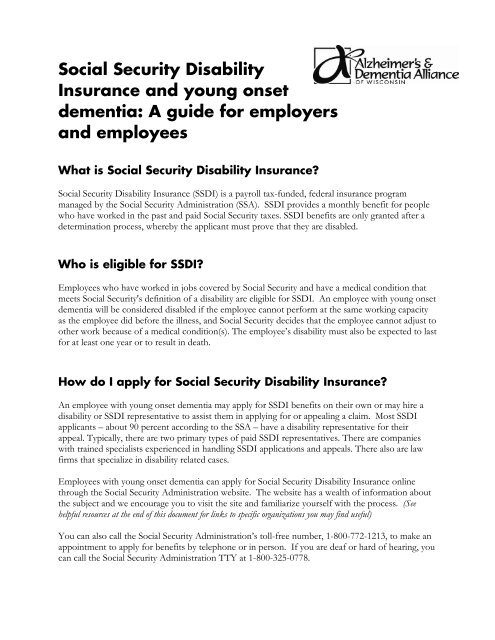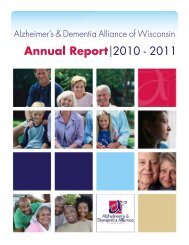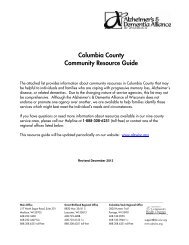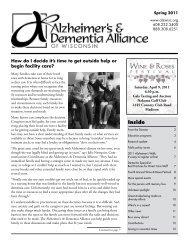Social Security Disability Insurance and young onset dementia: A ...
Social Security Disability Insurance and young onset dementia: A ...
Social Security Disability Insurance and young onset dementia: A ...
Create successful ePaper yourself
Turn your PDF publications into a flip-book with our unique Google optimized e-Paper software.
<strong>Social</strong> <strong>Security</strong> <strong>Disability</strong><br />
<strong>Insurance</strong> <strong>and</strong> <strong>young</strong> <strong>onset</strong><br />
<strong>dementia</strong>: A guide for employers<br />
<strong>and</strong> employees<br />
What is <strong>Social</strong> <strong>Security</strong> <strong>Disability</strong> <strong>Insurance</strong><br />
<strong>Social</strong> <strong>Security</strong> <strong>Disability</strong> <strong>Insurance</strong> (SSDI) is a payroll tax-funded, federal insurance program<br />
managed by the <strong>Social</strong> <strong>Security</strong> Administration (SSA). SSDI provides a monthly benefit for people<br />
who have worked in the past <strong>and</strong> paid <strong>Social</strong> <strong>Security</strong> taxes. SSDI benefits are only granted after a<br />
determination process, whereby the applicant must prove that they are disabled.<br />
Who is eligible for SSDI<br />
Employees who have worked in jobs covered by <strong>Social</strong> <strong>Security</strong> <strong>and</strong> have a medical condition that<br />
meets <strong>Social</strong> <strong>Security</strong>'s definition of a disability are eligible for SSDI. An employee with <strong>young</strong> <strong>onset</strong><br />
<strong>dementia</strong> will be considered disabled if the employee cannot perform at the same working capacity<br />
as the employee did before the illness, <strong>and</strong> <strong>Social</strong> <strong>Security</strong> decides that the employee cannot adjust to<br />
other work because of a medical condition(s). The employee’s disability must also be expected to last<br />
for at least one year or to result in death.<br />
How do I apply for <strong>Social</strong> <strong>Security</strong> <strong>Disability</strong> <strong>Insurance</strong><br />
An employee with <strong>young</strong> <strong>onset</strong> <strong>dementia</strong> may apply for SSDI benefits on their own or may hire a<br />
disability or SSDI representative to assist them in applying for or appealing a claim. Most SSDI<br />
applicants – about 90 percent according to the SSA – have a disability representative for their<br />
appeal. Typically, there are two primary types of paid SSDI representatives. There are companies<br />
with trained specialists experienced in h<strong>and</strong>ling SSDI applications <strong>and</strong> appeals. There also are law<br />
firms that specialize in disability related cases.<br />
Employees with <strong>young</strong> <strong>onset</strong> <strong>dementia</strong> can apply for <strong>Social</strong> <strong>Security</strong> <strong>Disability</strong> <strong>Insurance</strong> online<br />
through the <strong>Social</strong> <strong>Security</strong> Administration website. The website has a wealth of information about<br />
the subject <strong>and</strong> we encourage you to visit the site <strong>and</strong> familiarize yourself with the process. (See<br />
helpful resources at the end of this document for links to specific organizations you may find useful)<br />
You can also call the <strong>Social</strong> <strong>Security</strong> Administration’s toll-free number, 1-800-772-1213, to make an<br />
appointment to apply for benefits by telephone or in person. If you are deaf or hard of hearing, you<br />
can call the <strong>Social</strong> <strong>Security</strong> Administration TTY at 1-800-325-0778.
How long does it take to get <strong>Social</strong> <strong>Security</strong> <strong>Disability</strong><br />
<strong>Insurance</strong><br />
The <strong>Social</strong> <strong>Security</strong> Administration requires a five month waiting period before providing <strong>Social</strong><br />
<strong>Security</strong> <strong>Disability</strong> <strong>Insurance</strong> benefits. The five month waiting period ensures that during the early<br />
months of disability, the <strong>Social</strong> <strong>Security</strong> Administration does not pay benefits to persons who do not<br />
have long-term disabilities. Therefore, <strong>Social</strong> <strong>Security</strong> disability benefits will be paid beginning with<br />
the sixth full month after the date that their disability began. This is only an estimate, in practice<br />
filings can take up to eight months to complete. The appeals process for denied filings can likewise<br />
take 90 days to well over a year to get a hearing, depending on caseloads <strong>and</strong> persons are not entitled<br />
to benefits for any month in the waiting period.<br />
Several types of <strong>dementia</strong>, including those commonly experienced by employees with <strong>young</strong> <strong>onset</strong><br />
<strong>dementia</strong>, qualify for <strong>Social</strong> <strong>Security</strong> <strong>Disability</strong> <strong>Insurance</strong> under Compassionate Allowance.<br />
What is Compassionate Allowance <strong>and</strong> what conditions qualify<br />
for Compassionate Allowance<br />
Compassionate allowances allow <strong>Social</strong> <strong>Security</strong> to quickly target the most obviously disabled<br />
individuals for allowances based on objective medical information that can be quickly obtained (see<br />
below). To help ease the situation for those who are clearly disabled because of illness, the <strong>Social</strong><br />
<strong>Security</strong> Administration (SSA) maintains a list of conditions <strong>and</strong> diseases that are assumed to be<br />
disabling conditions that meet <strong>Social</strong> <strong>Security</strong>’s st<strong>and</strong>ards for disability. Called “compassionate<br />
allowances,” these disabling or life-threatening conditions qualify a person for an automatic approval<br />
for disability benefits. The Compassionate Allowance initiative significantly speeds up the process so<br />
that people with these conditions can get the benefits they need as soon as possible, often within<br />
days of filing for disability benefits. The original list of 50 qualifying conditions was exp<strong>and</strong>ed in<br />
February, 2010 to include 38 others including <strong>young</strong> <strong>onset</strong> Alzheimer’s disease.<br />
What <strong>young</strong> <strong>onset</strong> <strong>dementia</strong> conditions qualify for<br />
Compassionate Allowance<br />
The following conditions are on the <strong>Social</strong> <strong>Security</strong> Administration list of conditions that qualify for<br />
Compassionate Allowance. Also included are the diagnostic tests required to prove the employee<br />
with <strong>young</strong> <strong>onset</strong> <strong>dementia</strong> has the specific condition:<br />
Early-Onset Alzheimer’s Disease (AD) is the diagnosis of AD for a person <strong>young</strong>er than age 65<br />
years. AD is a degenerative, irreversible brain disease that usually affects older people <strong>and</strong> causes<br />
<strong>dementia</strong> characterized by the gradual loss of previously attained cognitive abilities, including<br />
memory, language, judgment, <strong>and</strong> ability to function. Physiological changes in the brain include the<br />
rampant growth of two abnormal structures, amyloid plaques <strong>and</strong> neurofibrillary tangles, which<br />
interrupt normal brain activity. The <strong>onset</strong> of AD is subtle; memory impairment is frequently its
earliest manifestation, quickly followed by learning <strong>and</strong> language impairments. Because people with<br />
early-<strong>onset</strong> AD are often in the work force it is not uncommon for the disease to first manifest as a<br />
decline or loss in their ability to perform work related activities. Depression is also a common early<br />
symptom.<br />
Diagnostic testing:<br />
The diagnosis of early-<strong>onset</strong> AD is based on the combination of clinical <strong>and</strong> family history;<br />
neurological, cognitive, or neuropsychological examination; <strong>and</strong> neuroimaging. Pertinent clinical<br />
information includes history of <strong>onset</strong> <strong>and</strong> description of cognitive <strong>and</strong> functional impairments at<br />
home <strong>and</strong> at work. Currently, there is no specific clinical or laboratory diagnostic test for early-<strong>onset</strong><br />
(or late-<strong>onset</strong>) AD <strong>and</strong> at present, the diagnosis can only be confirmed by brain biopsy or<br />
postmortem examination of the brain. A decline in Mini-Mental Status Examination (MMSE)<br />
scores over time is a likely indicator of possible <strong>dementia</strong>. Neuroimaging, such as computerized<br />
tomography (CT) or magnetic resonance imaging (MRI) is useful to demonstrate changes in the<br />
brain <strong>and</strong> to exclude other causes of <strong>dementia</strong>.<br />
Mixed Dementia is <strong>dementia</strong> caused by multiple etiologies including; Vascular <strong>dementia</strong>,<br />
Alzheimer’s disease, Parkinson’s <strong>dementia</strong>, Diffuse Lewy-body <strong>dementia</strong>, Frontotemporal <strong>dementia</strong><br />
(Pick’s disease), Huntington’s <strong>dementia</strong>; Prion <strong>dementia</strong>; Progressive Supranuclear Palsy (PSP).<br />
Mixed <strong>dementia</strong>s are conditions with more than one etiology for the <strong>dementia</strong>. The combination of<br />
the Vascular <strong>dementia</strong> <strong>and</strong> Alzheimer’s disease is the most common form. Mixed <strong>dementia</strong>s are<br />
characterized by progressive <strong>and</strong> persistent intellectual decline compromising at least two spheres of<br />
cognition (i.e. memory, language, orientation, attention, executive abilities, etc). These individuals<br />
may also have motor <strong>and</strong> gait impairment, affective disturbances <strong>and</strong> sleep disturbances.<br />
Diagnostic tests may include:<br />
The diagnoses of mixed <strong>dementia</strong>s are based on a clinical history of cognitive decline, neurologic<br />
<strong>and</strong> cognitive/neuropsychologic examination, <strong>and</strong> neuroimaging. Pertinent clinical information<br />
includes history of <strong>onset</strong> <strong>and</strong> description of cognitive <strong>and</strong> functional impairments at home <strong>and</strong> at<br />
work. History of a pervious stroke(s) adds to the likelihood of the diagnosis, but is not required.<br />
Currently, there is no specific clinical or laboratory test fo the diagnosis of Alzheimer’s disease <strong>and</strong><br />
its diagnosis can only be confirmed by brain biopsy or postmortem examination of the brain.<br />
Neuroimaging, i.e. computerized tomography (CT0or magnetic resonance imaging (MRI) is useful<br />
to demonstrate vascular lesions such as infarcts <strong>and</strong> lacunes, <strong>and</strong> to exclude other causes of<br />
<strong>dementia</strong>, some of which may be treatable.<br />
Primary Progressive Aphasia (PPA) is a type of <strong>dementia</strong> characterized by slow erosion of<br />
language (aphasia) over a two year period. It affects the language <strong>and</strong> semantic functioning<br />
(semantic <strong>dementia</strong>) <strong>and</strong> eventually progresses to amnesia. People with primary progressive aphasia<br />
may have trouble naming objects or may misuse word endings, verb tenses, conjunctions <strong>and</strong><br />
pronouns. Primary progressive aphasia is a type of frontotemporal <strong>dementia</strong>, a group of related<br />
disorders in the frontal or temporal lobes of the brain. Most people with primary progressive aphasia<br />
maintain ability to take care of themselves, pursue hobbies, <strong>and</strong>, in some instances, remain<br />
employed.<br />
Diagnostic tests may include:<br />
• Clinical exam,<br />
• Speech/language evaluation that examines word retrieval, sentence formulation, <strong>and</strong> auditory<br />
comprehension skills,
• MRI or CT scan of the brain demonstrating atrophy of the brain language areas or of the<br />
frontal <strong>and</strong> temporal lobes.<br />
Frontotemporal Dementia (FTD), Pick’s Disease-Type A, is a syndrome associated with<br />
shrinking of the frontal <strong>and</strong> temporal anterior lobes of the brain. The presence of abnormalities in<br />
the nerve cells of the brain, called Pick bodies, distinguishes frontal lobe <strong>dementia</strong> from other types<br />
of <strong>dementia</strong>. The symptoms associated with Frontotemporal Dementia express themselves either<br />
through changes in behavior or problems with language. People experiencing Pick’s type symptoms<br />
associated with behavior will have the greatest challenges with employment. Pick's disease generally<br />
occurs between the ages of forty <strong>and</strong> sixty years of age.<br />
Diagnostic tests may include:<br />
• Physical exam, clinical assessment <strong>and</strong> blood tests<br />
• Neurological exam that checks awareness <strong>and</strong> responsiveness, vital signs, reflexes, sensory<br />
responses <strong>and</strong> coordination<br />
• Neuropsychological testing, which assesses memory, ability to reason <strong>and</strong> judge, problemsolving<br />
skills <strong>and</strong> language skills. Brain imagining, such as MRI <strong>and</strong> CT, may demonstrate<br />
shrinkage of the frontal <strong>and</strong> temporal lobes <strong>and</strong> also help exclude other causes of <strong>dementia</strong><br />
such as strokes <strong>and</strong> brain tumors. PET <strong>and</strong> SPEC tomography testing may be used to<br />
evaluate brain activity.<br />
Creutzfeldt-Jakob Disease (CJD) is a rare, rapidly progressive, fatal brain disorder primarily<br />
characterized by mental deterioration, although motor problems can be significant in many cases.<br />
CJD belongs to a group of human <strong>and</strong> animal diseases known as transmissible spongiform<br />
encephalopathies (TSE) or prion diseases. Typically, <strong>onset</strong> of symptoms occurs at about age 60 <strong>and</strong><br />
runs a rapid course. There are four major categories of CJD: sporadic CJD, hereditary CJD,<br />
acquired or iatrogenic CJD <strong>and</strong> variant CJD. Sporadic CJD is the most common form of the disease<br />
<strong>and</strong> accounts for 85% of cases. The cause of sporadic CJD is unknown, but it is believed that a<br />
normal cellular protein undergoes a spontaneous change in conformation that results in the disease.<br />
Hereditary of familial CJD is a very uncommon disease <strong>and</strong> the consequence of a mutation in the<br />
gene that encodes the prior protein. About 5 to 10 percent of CJD cases are hereditary. Acquired<br />
or Iatrogenic CJD is also very rare accounting for less than 1 percent of cases <strong>and</strong> results from the<br />
accidental transmission during medical interventions. Variant CJD was first reported in 1996. It is<br />
believed to be the result of eating meat from cattle with bovine spongiform encephalophy (mad cow<br />
disease).<br />
Diagnostic testing:<br />
The diagnosis of CJD is suspected when there are typical clinical symptoms such as rapidly<br />
progressing <strong>dementia</strong> with myoclonus (twitching). Currently, there is no single diagnostic test for<br />
CJD except for brain biopsy. The first concern is to rule out treatable forms of <strong>dementia</strong> such as<br />
encephalitis or chronic meningitis. Common investigations include:<br />
• Electroencephalography,<br />
• MRI of the brain,<br />
• Cerebrospinal fluid analysis<br />
• Tonsil biopsy is helpful in the diagnosis of variant CJD, but less so in other forms of the<br />
disease.
Helpful resources:<br />
<strong>Social</strong> <strong>Security</strong> Administration: Link to online disability application<br />
http://www.socialsecurity.gov/applyfordisability/<br />
<strong>Disability</strong> Rights Wisconsin<br />
www.disabilityrightswi.org<br />
State Bar of Wisconsin<br />
www.wisbar.org<br />
Coalition of Wisconsin Aging Groups, Elder Law Section<br />
www.cwag.org<br />
The Alzheimer’s & Dementia Alliance of Wisconsin<br />
http://www.alzwisc.org<br />
Your local Aging <strong>and</strong> <strong>Disability</strong> Resource Center<br />
http://www.dhs.wisconsin.gov/ltcare/adrc/<br />
The Alzheimer’s Association<br />
http://www.alz.org<br />
Employment Resources Inc<br />
www.eri-wi.org<br />
For further information please contact the Alzheimer’s & Dementia Alliance at 608-232-3400<br />
or toll free at 888-308-6251








